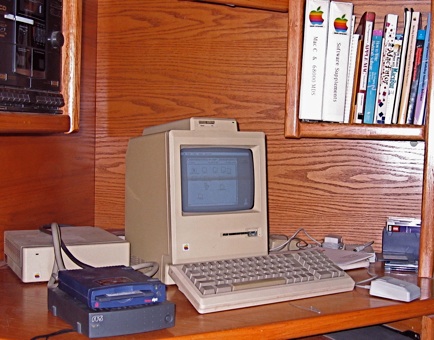Retro Mac Computing


Early Life
My Mac Plus started life as a 512K Fat Mac. I bought it in October 1984. I ordered it at the time of the announcement, and had to wait for my campus bookstore to order and receive it. It got the upgrade to Mac Plus in early 1986, and extra memory at the same time. The Radius accelerator was a product that was never supposed to happen. The computer had been built to be unmodifiable, despite the best efforts of Burrell Smith, the designer of its logic board (see the story entitled Diagnostic Port at folklore.org). But when he and others from the original Mac team left Apple to form the Radius company, their first two products were amazing modifications to the Mac that only they could have made. The first was a full page portrait display and the second was the 68020/68881 accelerator board. Both are daughter boards that sit atop the logic board inside the mac, where there is basically no room. It was supposed to be possible to install them both on a single machine, and that must have been quite a difficult install job. I had two Macs, one that got the full page display and one that got the accelerator. Both were installed at the Opus 2 Computer store, that was located at 747 E. Brookhaven Circle in Memphis. Opus 2 was an Apple-only computer store, and also a very up-market dealer in audio equipment. The Apple Stores are great, but I’d gladly trade them in for a chain of stores as good as Opus 2.
The Radius Accelerator
The Radius accelerator made the Mac Plus really hum, and this one is still a joy to use. To get the correct feel, run the Mini vMac accelerator at the 2x speed setting. It feels just about as fast as any mac you use now, in the speed at which user interface items like menus and windows respond to the mouse. It’s impossible to type ahead of it in a text editor or word processor. The Mac Plus is only working on what you are working on. There are never unexpected delays while it speeds up again after the energy saver slowed it down or because it is working on who-knows-what in the background. The accelerator upgrade doubled the clock speed and it really did double the speed of the response. I can’t remember when any upgrade has been so noticeable. But the thing that really made a difference was floating point. The original macs didn’t have floating point processors. Floating point arithmetic was done in software by a system software component (called a package) that emulated floating point operations using integer arithmetic. It was very accurate, but very slow. I remember reading at the time that the accelerator would increase floating performance by 90 times. I never measured it, but I think this estimate is pretty close. At the time, I was writing mac programs for work that were very floating point intensive. When a big calculation was going on, I put up a dialog box that said something like “calculating impulse response, please be patient”, and put a timer there so you could see how patient you had been. It usually took something close to a minute. When I got the same program running using the 68881, the calculation was done in less than a second, and I ended up doing away with the dialog box. One bad thing about the floating point unit was that I had to give up the use of my beloved Consulair Mac C programming suite. It didn’t generate code for the floating point unit. But I replaced it with Apples MPW, which did, and MPW turned out to be the coolest programming system I ever used.
As It Is Now
The Mac Plus works better now than it ever did. I usually run System 6.0.8. I have a great collection of System 6 software, and some software accomplishments made back then have never been equalled in later systems. In the picture you can see the HD20, an Apple hard disk that I got before the Plus upgrade, and continued to use for many years. It is slow as molasses and only 20 MB, and I don’t use it any more. To the left of the unit, there is an APS SCSI enclosure that contains a 80 MB hard disk that I took out of my PowerBook 180 when I upgraded it’s disk (I wish I still had that Powerbook, 180 -- it was sweet). There is also a 100 MB Zip drive. I can boot from either drive. For information on booting a Mac Plus from a Zip drive, see this. The zip is a good way to duplicate my entire Mac Plus environment to use on Mini vMac. But Mini vMac still can’t execute my floating point code, and there is no substitute for the real thing. In the picture you see a platinum mouse, which is a recent addition. The ball in the old beige mouse is old and cracked. When I bought the new mouse I meant just to take the ball out of it and put it in the beige one. One of these days I will.
Mac Plus, 4 MB memory, Radius 16MHz 68020/68881
